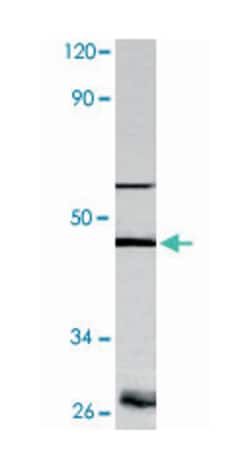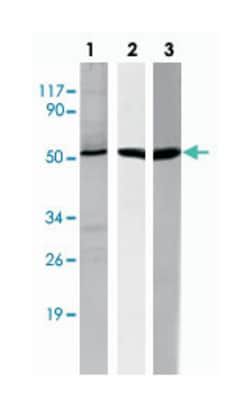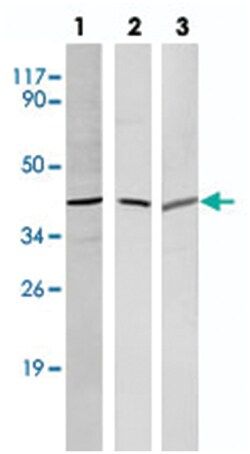89-126-404
CASP8 Rabbit anti-Human, Polyclonal Antibody, Abnova™
Manufacturer: Abnova Corporation
Select a Size
| Pack Size | SKU | Availability | Price |
|---|---|---|---|
| Each of 1 | 89-126-404-Each-of-1 | In Stock | ₹ 70,488.00 |
89-126-404 - Each of 1
In Stock
Quantity
1
Base Price: ₹ 70,488.00
GST (18%): ₹ 12,687.84
Total Price: ₹ 83,175.84
Antigen
CASP8
Classification
Polyclonal
Description
Rabbit polyclonal antibody raised against synthetic peptide of CASP8.
Formulation
In PBS, pH 7.2 (0.09% sodium azide)
Gene Alias
ALPS2B/CAP4/FLICE/FLJ17672/MACH/MCH5/MGC78473
Host Species
Rabbit
Purification Method
Antigen affinity purification
Regulatory Status
RUO
Gene ID (Entrez)
841
Target Species
Human
Form
Liquid
Applications
Western Blot
Conjugate
Unconjugated
Dilution
Western Blot (1:500-1:1000) The optimal working dilution should be determined by the end user.
Gene
CASP8
Gene Symbols
CASP8
Immunogen
A synthetic peptide corresponding to CASP8.
Quantity
100 μL
Primary or Secondary
Primary
Test Specificity
CASP8 polyclonal antibody detects endogenous levels of CASP8 protein.
Content And Storage
Store at 4°C. For long term storage store at -20°C.Aliquot to avoid repeated freezing and thawing.
Description
- This gene encodes a member of the cysteine-aspartic acid protease (caspase) family
- Sequential activation of caspases plays a central role in the execution-phase of cell apoptosis
- Caspases exist as inactive proenzymes composed of a prodomain, a large protease subunit, and a small protease subunit
- Activation of caspases requires proteolytic processing at conserved internal aspartic residues to generate a heterodimeric enzyme consisting of the large and small subunits
- This protein is involved in the programmed cell death induced by Fas and various apoptotic stimuli
- The N-terminal FADD-like death effector domain of this protein suggests that it may interact with Fas-interacting protein FADD
- This protein was detected in the insoluble fraction of the affected brain region from Huntington disease patients but not in those from normal controls, which implicated the role in neurodegenerative diseases
- Many alternatively spliced transcript variants encoding different isoforms have been described, although not all variants have had their full-length sequences determined
- [provided by RefSeq
Compare Similar Items
Show Difference
Antigen: CASP8
Classification: Polyclonal
Description: Rabbit polyclonal antibody raised against synthetic peptide of CASP8.
Formulation: In PBS, pH 7.2 (0.09% sodium azide)
Gene Alias: ALPS2B/CAP4/FLICE/FLJ17672/MACH/MCH5/MGC78473
Host Species: Rabbit
Purification Method: Antigen affinity purification
Regulatory Status: RUO
Gene ID (Entrez): 841
Target Species: Human
Form: Liquid
Applications: Western Blot
Conjugate: Unconjugated
Dilution: Western Blot (1:500-1:1000) The optimal working dilution should be determined by the end user.
Gene: CASP8
Gene Symbols: CASP8
Immunogen: A synthetic peptide corresponding to CASP8.
Quantity: 100 μL
Primary or Secondary: Primary
Test Specificity: CASP8 polyclonal antibody detects endogenous levels of CASP8 protein.
Content And Storage: Store at 4°C. For long term storage store at -20°C.Aliquot to avoid repeated freezing and thawing.
Antigen:
CASP8
Classification:
Polyclonal
Description:
Rabbit polyclonal antibody raised against synthetic peptide of CASP8.
Formulation:
In PBS, pH 7.2 (0.09% sodium azide)
Gene Alias:
ALPS2B/CAP4/FLICE/FLJ17672/MACH/MCH5/MGC78473
Host Species:
Rabbit
Purification Method:
Antigen affinity purification
Regulatory Status:
RUO
Gene ID (Entrez):
841
Target Species:
Human
Form:
Liquid
Applications:
Western Blot
Conjugate:
Unconjugated
Dilution:
Western Blot (1:500-1:1000) The optimal working dilution should be determined by the end user.
Gene:
CASP8
Gene Symbols:
CASP8
Immunogen:
A synthetic peptide corresponding to CASP8.
Quantity:
100 μL
Primary or Secondary:
Primary
Test Specificity:
CASP8 polyclonal antibody detects endogenous levels of CASP8 protein.
Content And Storage:
Store at 4°C. For long term storage store at -20°C.Aliquot to avoid repeated freezing and thawing.
Antigen: CASP9
Classification: Polyclonal
Description: Rabbit polyclonal antibody raised against synthetic peptide of CASP9.
Formulation: In PBS, pH 7.2 (0.09% sodium azide)
Gene Alias: APAF-3/APAF3/CASPASE-9c/ICE-LAP6/MCH6
Host Species: Rabbit
Purification Method: Antigen affinity purification
Regulatory Status: RUO
Gene ID (Entrez): 842
Target Species: Human
Form: Liquid
Applications: Western Blot
Conjugate: Unconjugated
Dilution: Western Blot (1:500-1:1000) The optimal working dilution should be determined by the end user.
Gene: CASP9
Gene Symbols: CASP9
Immunogen: A synthetic peptide corresponding to CASP9.
Quantity: 100 μL
Primary or Secondary: Primary
Test Specificity: CASP9 polyclonal antibody detects endogenous levels of CASP9 protein.
Content And Storage: Store at 4°C. For long term storage store at -20°C.Aliquot to avoid repeated freezing and thawing.
Antigen:
CASP9
Classification:
Polyclonal
Description:
Rabbit polyclonal antibody raised against synthetic peptide of CASP9.
Formulation:
In PBS, pH 7.2 (0.09% sodium azide)
Gene Alias:
APAF-3/APAF3/CASPASE-9c/ICE-LAP6/MCH6
Host Species:
Rabbit
Purification Method:
Antigen affinity purification
Regulatory Status:
RUO
Gene ID (Entrez):
842
Target Species:
Human
Form:
Liquid
Applications:
Western Blot
Conjugate:
Unconjugated
Dilution:
Western Blot (1:500-1:1000) The optimal working dilution should be determined by the end user.
Gene:
CASP9
Gene Symbols:
CASP9
Immunogen:
A synthetic peptide corresponding to CASP9.
Quantity:
100 μL
Primary or Secondary:
Primary
Test Specificity:
CASP9 polyclonal antibody detects endogenous levels of CASP9 protein.
Content And Storage:
Store at 4°C. For long term storage store at -20°C.Aliquot to avoid repeated freezing and thawing.
Antigen: TUBB3
Classification: Polyclonal
Description: Rabbit polyclonal antibody raised against synthetic peptide of TUBB3.
Formulation: In PBS, pH 7.2 (0.05% sodium azide)
Gene Alias: MC1R/TUBB4/beta-4
Host Species: Rabbit
Purification Method: Antigen affinity purification
Regulatory Status: RUO
Gene ID (Entrez): 10381
Target Species: Human, Mouse, Rat
Form: Liquid
Applications: Western Blot
Conjugate: Unconjugated
Dilution: Western Blot (1:5000-1:10000) The optimal working dilution should be determined by the end user.
Gene: TUBB3
Gene Symbols: TUBB3
Immunogen: A synthetic peptide corresponding to TUBB3.
Quantity: 100 μL
Primary or Secondary: Primary
Test Specificity: TUBB3 polyclonal antibody detects endogenous levels of TUBB3 protein.
Content And Storage: Store at 4°C. For long term storage store at -20°C.Aliquot to avoid repeated freezing and thawing.
Antigen:
TUBB3
Classification:
Polyclonal
Description:
Rabbit polyclonal antibody raised against synthetic peptide of TUBB3.
Formulation:
In PBS, pH 7.2 (0.05% sodium azide)
Gene Alias:
MC1R/TUBB4/beta-4
Host Species:
Rabbit
Purification Method:
Antigen affinity purification
Regulatory Status:
RUO
Gene ID (Entrez):
10381
Target Species:
Human, Mouse, Rat
Form:
Liquid
Applications:
Western Blot
Conjugate:
Unconjugated
Dilution:
Western Blot (1:5000-1:10000) The optimal working dilution should be determined by the end user.
Gene:
TUBB3
Gene Symbols:
TUBB3
Immunogen:
A synthetic peptide corresponding to TUBB3.
Quantity:
100 μL
Primary or Secondary:
Primary
Test Specificity:
TUBB3 polyclonal antibody detects endogenous levels of TUBB3 protein.
Content And Storage:
Store at 4°C. For long term storage store at -20°C.Aliquot to avoid repeated freezing and thawing.
Antigen: SOX2
Classification: Polyclonal
Description: Rabbit polyclonal antibody raised against synthetic peptide of SOX2.
Formulation: In PBS, pH 7.2 (0.05% sodium azide)
Gene Alias: ANOP3/MCOPS3/MGC2413
Host Species: Rabbit
Purification Method: Antigen affinity purification
Regulatory Status: RUO
Gene ID (Entrez): 6657
Target Species: Human, Mouse, Rat
Form: Liquid
Applications: Western Blot
Conjugate: Unconjugated
Dilution: Western Blot (1:1000-1:5000) The optimal working dilution should be determined by the end user.
Gene: SOX2
Gene Symbols: SOX2
Immunogen: A synthetic peptide corresponding to SOX2.
Quantity: 100 μL
Primary or Secondary: Primary
Test Specificity: SOX2 polyclonal antibody detects endogenous levels of SOX2 protein.
Content And Storage: Store at 4°C. For long term storage store at -20°C.Aliquot to avoid repeated freezing and thawing.
Antigen:
SOX2
Classification:
Polyclonal
Description:
Rabbit polyclonal antibody raised against synthetic peptide of SOX2.
Formulation:
In PBS, pH 7.2 (0.05% sodium azide)
Gene Alias:
ANOP3/MCOPS3/MGC2413
Host Species:
Rabbit
Purification Method:
Antigen affinity purification
Regulatory Status:
RUO
Gene ID (Entrez):
6657
Target Species:
Human, Mouse, Rat
Form:
Liquid
Applications:
Western Blot
Conjugate:
Unconjugated
Dilution:
Western Blot (1:1000-1:5000) The optimal working dilution should be determined by the end user.
Gene:
SOX2
Gene Symbols:
SOX2
Immunogen:
A synthetic peptide corresponding to SOX2.
Quantity:
100 μL
Primary or Secondary:
Primary
Test Specificity:
SOX2 polyclonal antibody detects endogenous levels of SOX2 protein.
Content And Storage:
Store at 4°C. For long term storage store at -20°C.Aliquot to avoid repeated freezing and thawing.



